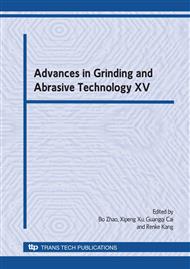p.568
p.572
p.578
p.583
p.588
p.593
p.598
p.603
p.609
Study on the Phase Transition Characteristics in Ultrasonic High Efficiency Lapped Surface of Engineering Ceramics
Abstract:
Surface phase structure has an important effect on the surface machining quality. The surface phase transition characteristics of ZrO2 and ZTA ceramics under different machining methods were tested by X-ray diffraction in the paper. Through the qualitative and quantitative phase analyses, the influences of several different precision machining methods on the phase transitions in the machined surface were studied. Research results show that there are more transitions from tetragonal phase ZrO2 to monoclinic phase ZrO2 in the high speed grinding surface; because of the high-frequency vibration of lapping tool in ultrasonic lapping, the stress condition in the grinding area can be improved and the stable tetragonal phase ZrO2 in the ultrasonic lapped surface is easy to get. The research conclusions have important significance on analyzing the surface residual stress and improving the surface machining quality of engineering ceramics.
Info:
Periodical:
Pages:
588-592
Citation:
Online since:
September 2009
Authors:
Price:
Сopyright:
© 2009 Trans Tech Publications Ltd. All Rights Reserved
Share:
Citation:


